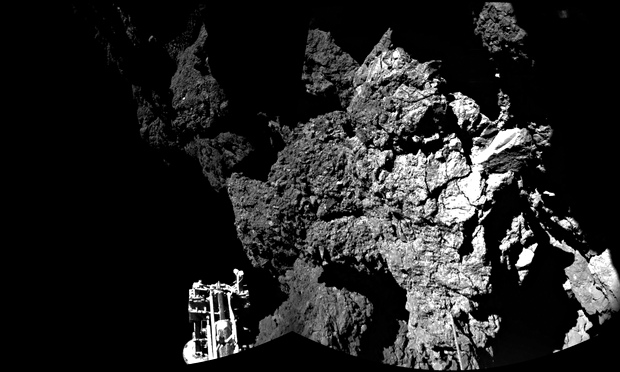Sorry for the silly title. That’s just how I roll sometimes.
Anyhow, if you haven’t been following the story, there’s been a lot of news from Comet 67P since the Philae lander made its giant leap for robotkind on Wednesday, and some of it, I’m sorry to say, is quite disappointing. But first, here’s this:
 Photograph: European Space Agency/AFP/Getty Images
Photograph: European Space Agency/AFP/Getty Images
That is the very first image taken from the surface of a comet. The metal doohickey you see at the bottom (more-or-less) center is one of Philae’s three landing-gear “feet,” and surprisingly the surface appears to be solid and rocky (there was some expectation that it would be powdery, or a mixture of ice and gravel loosely packed like a snowcone). So there’s an interesting discovery right off the bat.
Scientists with the ESA have determined that the lander bounced not just once as I wrote the other day, but twice after its initial contact with the surface, each time settling slowly back down in the super-low gravity while the comet rotated beneath it, finally coming to rest some distance away from the planned landing zone. Nobody’s certain exactly where on 67P it ended up; the ESA crew has used cameras on the orbiting Rosetta probe to try and pinpoint Philae’s location, but haven’t had any luck spotting it. In addition, Philae apparently landed on its side, with one landing leg sticking up into space, and none of the systems designed to anchor it to the surface functioned. It’s just sitting there, possibly precariously — there was even some concern at one point that using the drill to dig out a core sample could dislodge the lander and send it back into space.
Most worrisome though is the fact that Philae isn’t receiving enough sunlight to recharge its batteries — its solar panels are shaded by tall landscape features around it, outcroppings or maybe cliff walls, and power levels are dropping rapidly. It’s expected the lander will flatline early Saturday. Possibly as the comet nears the sun in a few months, the panels might charge enough to restart Philae, but that’s probably a long shot. One possibility the engineers are considering is trying to spin up an internal flywheel that helped Philae orient itself in space; it’s thought that the flywheel might provide enough torque to reposition the probe and bring the solar panels more into the light, but again it’s probably a long shot. The mission is most likely going to be much shorter than originally hoped.
On the positive side, the lander is working. The various instruments are all functioning, collecting and transmitting data back to Rosetta for relay to Earth. I can’t wait to find out what we’re learning from it.
Meanwhile, in other space-related news:
- NASA’s Orion capsule, the spacecraft that’s supposed to take astronauts back to deep space, whether that means to the moon or on to Mars or someplace else, arrived at Cape Canaveral on Wednesday. It’s since been mounted on top of a Delta IV Heavy booster rocket and moved to the launch pad in preparation for its first unmanned test flight, which is scheduled to occur on December 4.
- The NTSB is still investigating exactly what happened that led to the disintegration of Virgin Galactic’s SpaceShipTwo, but accounts are emerging of what test pilot Peter Siebold endured on his way back to Earth. Essentially he was thrown clear as the rocketplane broke up around him at 50,000 feet — twice the height of Mount Everest. The air at that altitude is very thin and very cold — minus-70 degrees Fahrenheit — and Siebold and his copilot, the late Michael Alsbury, were not wearing pressure suits, so he lost consciousness within seconds. Fortunately, his parachute deployed automatically and Siebold woke up in the lower, denser atmosphere as he neared the ground. What an incredible survival story…
- And finally, Orbital Sciences, the company whose Antares rocket had to be self-destructed shortly after lift-off, says it believes a turbopump in one of the rocket’s two motors malfunctioned, leading a loss of thrust. The engines on this rocket are actually old Soviet surplus from 1970s, and Orbital has had problems with them before. As of now, the company says it will no longer use these engines and will retrofit its other Antares with newer propulsion systems, and hopes to get the Antares flying again in 2016. In the meantime, Orbital is negotiating with other launch providers to help them fulfill their cargo-delivery contracts with NASA.

